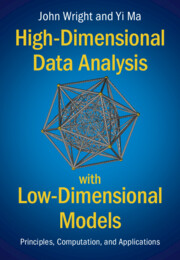Refine listing
Actions for selected content:
9096 results in Communications, Signal Processing and Information Theory
6 - Neural Networks and Deep Learning
-
- Book:
- Machine Learning
- Published online:
- 27 May 2022
- Print publication:
- 31 March 2022, pp 133-162
-
- Chapter
- Export citation
Acknowledgements
-
- Book:
- Machine Learning
- Published online:
- 27 May 2022
- Print publication:
- 31 March 2022, pp ix-x
-
- Chapter
- Export citation
2 - Supervised Learning: A First Approach
-
- Book:
- Machine Learning
- Published online:
- 27 May 2022
- Print publication:
- 31 March 2022, pp 13-36
-
- Chapter
- Export citation
Frontmatter
-
- Book:
- Machine Learning
- Published online:
- 27 May 2022
- Print publication:
- 31 March 2022, pp i-iv
-
- Chapter
- Export citation
11 - User Aspects of Machine Learning
-
- Book:
- Machine Learning
- Published online:
- 27 May 2022
- Print publication:
- 31 March 2022, pp 287-308
-
- Chapter
- Export citation
Notation
-
- Book:
- Machine Learning
- Published online:
- 27 May 2022
- Print publication:
- 31 March 2022, pp xi-xii
-
- Chapter
- Export citation
Contents
-
- Book:
- Machine Learning
- Published online:
- 27 May 2022
- Print publication:
- 31 March 2022, pp v-viii
-
- Chapter
- Export citation
4 - Understanding, Evaluating, and Improving Performance
-
- Book:
- Machine Learning
- Published online:
- 27 May 2022
- Print publication:
- 31 March 2022, pp 63-90
-
- Chapter
- Export citation
5 - Learning Parametric Models
-
- Book:
- Machine Learning
- Published online:
- 27 May 2022
- Print publication:
- 31 March 2022, pp 91-132
-
- Chapter
- Export citation
8 - Non-linear Input Transformations and Kernels
-
- Book:
- Machine Learning
- Published online:
- 27 May 2022
- Print publication:
- 31 March 2022, pp 189-216
-
- Chapter
- Export citation
10 - Generative Models and Learning from Unlabelled Data
-
- Book:
- Machine Learning
- Published online:
- 27 May 2022
- Print publication:
- 31 March 2022, pp 247-286
-
- Chapter
- Export citation
Index
-
- Book:
- Machine Learning
- Published online:
- 27 May 2022
- Print publication:
- 31 March 2022, pp 335-338
-
- Chapter
- Export citation
9 - The Bayesian Approach and Gaussian Processes
-
- Book:
- Machine Learning
- Published online:
- 27 May 2022
- Print publication:
- 31 March 2022, pp 217-246
-
- Chapter
- Export citation
12 - Ethics in Machine Learning
-
- Book:
- Machine Learning
- Published online:
- 27 May 2022
- Print publication:
- 31 March 2022, pp 309-326
-
- Chapter
- Export citation
7 - Ensemble Methods: Bagging and Boosting
-
- Book:
- Machine Learning
- Published online:
- 27 May 2022
- Print publication:
- 31 March 2022, pp 163-188
-
- Chapter
- Export citation

High-Dimensional Data Analysis with Low-Dimensional Models
- Principles, Computation, and Applications
-
- Published online:
- 11 March 2022
- Print publication:
- 13 January 2022
-
- Textbook
- Export citation

Fundamentals of Classical and Modern Error-Correcting Codes
-
- Published online:
- 02 February 2022
- Print publication:
- 09 December 2021
-
- Textbook
- Export citation
16 - Deep Networks for Classification
- from Part III - Applications to Real-World Problems
-
- Book:
- High-Dimensional Data Analysis with Low-Dimensional Models
- Published online:
- 11 March 2022
- Print publication:
- 13 January 2022, pp 526-572
-
- Chapter
- Export citation
8 - Convex Optimization for Structured Signal Recovery
- from Part II - Computation for Large-Scale Problems
-
- Book:
- High-Dimensional Data Analysis with Low-Dimensional Models
- Published online:
- 11 March 2022
- Print publication:
- 13 January 2022, pp 305-364
-
- Chapter
- Export citation
7 - Nonconvex Methods for Low-Dimensional Models
- from Part I - Principles of Low-Dimensional Models
-
- Book:
- High-Dimensional Data Analysis with Low-Dimensional Models
- Published online:
- 11 March 2022
- Print publication:
- 13 January 2022, pp 263-302
-
- Chapter
- Export citation
